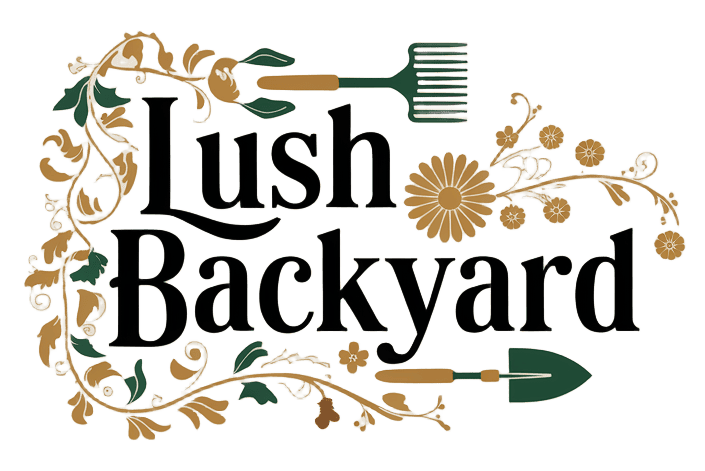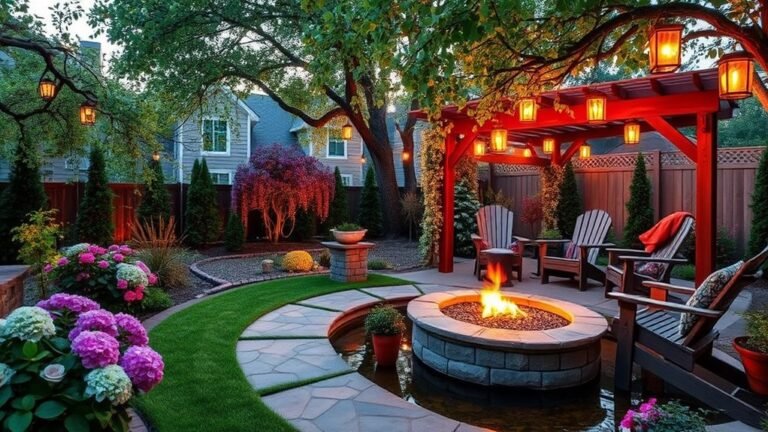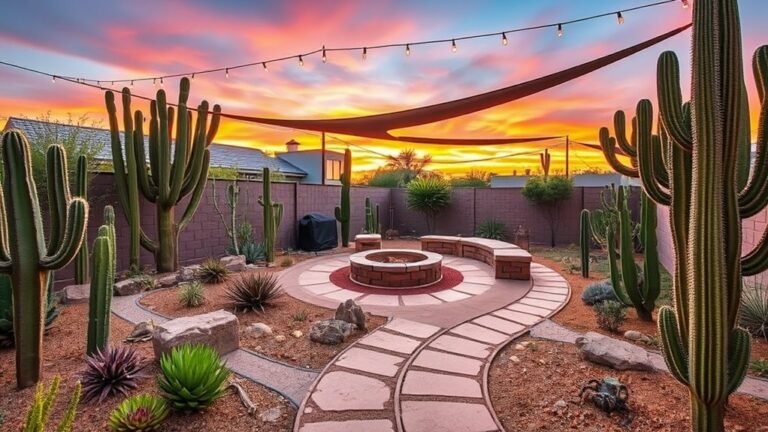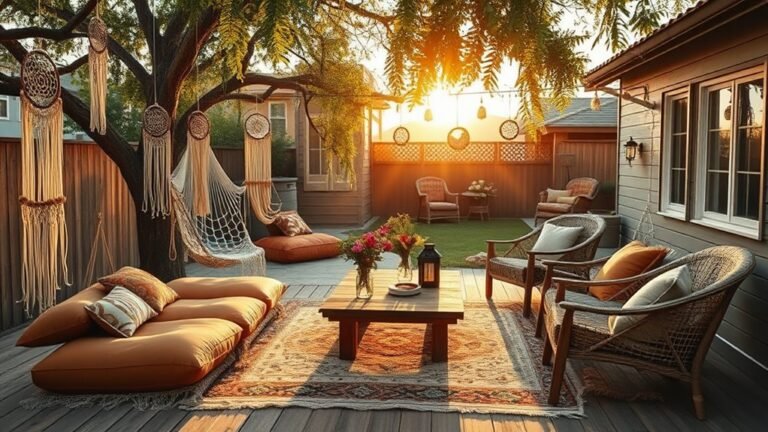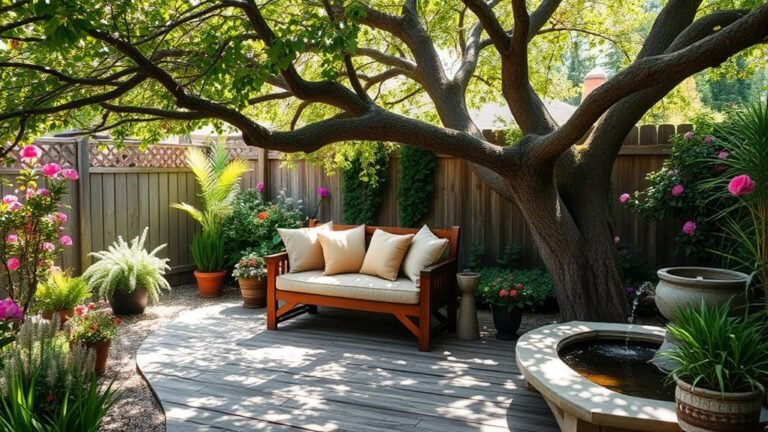14 Landscaping Ideas for a Wet Backyard

A wet backyard may seem limiting for landscaping, but there are numerous creative options available. By incorporating features like rain gardens and permeable pavers, you can manage excess water while enhancing your yard's appeal.
Consider practical solutions such as French drains to redirect water effectively. With thoughtful planning, you can transform your soggy space into a beautiful and functional outdoor environment.
Build a Rain Garden

If you want to manage excess water in your wet backyard, building a rain garden is a great solution. Picture a beautiful garden that absorbs rainwater, keeping your yard dry and vibrant.
Start by selecting a low area where water accumulates. Dig a shallow depression and fill it with native plants that thrive in wet conditions, such as coneflowers or black-eyed Susans. These plants absorb water and attract butterflies and bees, enhancing your space's beauty.
Consider designing your rain garden with layers to slow down water flow and promote better absorption, adding a unique look. Decorative stones or mulch can further enhance its appeal.
A rain garden can transform your wet backyard into an ecological oasis. So, get ready to dig in—your yard will appreciate it!
Install a French Drain

Installing a French drain is an effective way to redirect excess water from your wet backyard, transforming it into a dry, usable space! A French drain consists of a gravel-filled trench with a perforated pipe that captures and channels water away from problem areas. This will keep your plants healthy and eliminate standing water.
Here's a quick overview of the main steps:
| Step | Description | Time Needed |
|---|---|---|
| Planning | Identify the best location and slope | 1-2 hours |
| Digging the Trench | Excavate a trench about 6 inches wide and 18 inches deep | 2-4 hours |
| Laying the Pipe | Install the perforated pipe in the trench | 1-2 hours |
| Covering with Gravel | Fill the trench with gravel for drainage | 1 hour |
After installing the drain, you'll see a significant improvement. So roll up your sleeves and tackle that water issue—your future self will thank you!
Create a Wetland Area

Creating a wetland area in your backyard can effectively manage excess water while enhancing its beauty.
Start by choosing a low spot that retains water and dig a shallow basin wide enough for wetland plants. Line the bottom with gravel for proper drainage, then add a mix of rich, organic soil, ensuring levels vary to mimic natural water flow and support diverse wildlife.
Fill the basin with water and watch your oasis come alive! You may attract frogs and dragonflies, enriching your outdoor experience.
Imagine sipping coffee while observing this vibrant ecosystem. Grab your shovel and get ready to create your wetland paradise!
Use Native Plants

When designing your wet backyard, using native plants is crucial as they thrive in local conditions and support the ecosystem.
These resilient, low-maintenance plants are perfectly suited for wet environments and attract local wildlife, enhancing your garden with the sounds of chirping birds and buzzing bees.
Consider incorporating plants like blue flag iris, swamp milkweed, or cardinal flower.
These not only flourish in wet soil but also add vibrant color to your landscape. Using native plants allows you to create a lively yard effortlessly while letting nature work its magic.
Additionally, native plants require less water and fertilizer than non-natives, helping you save on gardening costs and time.
This means more enjoyment of your backyard paradise!
Incorporate Permeable Pavers
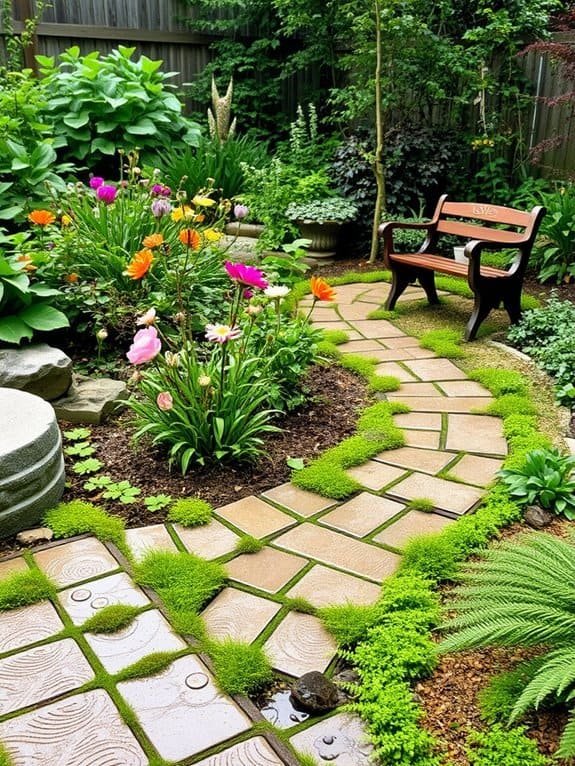
Enhancing your wet backyard can involve thoughtful hardscaping choices, such as incorporating permeable pavers.
These innovative pavers allow water to pass through, reducing puddles and keeping your yard fresh and inviting while adding a stylish touch.
Imagine strolling across a beautiful patio that not only looks good but also improves drainage, giving your yard a cozy, breathable feel.
Here are some emotional benefits of choosing permeable pavers:
- Reduced flooding: Eliminate those pesky puddles that spoil your BBQs.
- Eco-friendly vibes: Contribute to environmental sustainability and feel great about it!
- Versatile designs: Create a unique look that reflects your style, from classic to modern.
- Cool surfaces: Walk barefoot on your patio without burning your feet!
Incorporating permeable pavers is practical and a fun way to enhance your backyard's charm.
Let those pavers work their magic, and watch your wet yard transform into a vibrant, functional space!
Consider using interlocking deck tiles that are weather-resistant and provide an excellent drainage design for even better backyard performance.
Design a Dry Creek Bed

A dry creek bed can enhance your wet backyard by effectively managing excess water while adding visual appeal.
Picture a winding path of smooth stones that directs rainwater away from your home like a stylish highway!
To create your dry creek bed, select a spot where water pools.
Dig a 12-inch-wide trench for drainage and line it with landscape fabric to prevent weeds. Fill it with gravel or river rocks, incorporating larger stones for added interest.
Remember, the shape can be gentle and curvy to mimic natural design.
Consider adding decorative elements like driftwood or small boulders to further enhance the aesthetic.
Plant Moisture-Tolerant Shrubs

Incorporating a dry creek bed can effectively manage water, but selecting the right moisture-tolerant shrubs for your wet backyard is vital.
These plants not only thrive in soggy conditions but also enhance your landscape's beauty. Picture a vibrant oasis in your yard!
Consider these great options:
- Buttonbush: Its unique fluffy flowers attract butterflies and bees, inviting delightful visitors.
- Swamp Azalea: Fragrant blooms create a sensory paradise and spark conversations.
- Red Twig Dogwood: Striking red stems provide stunning winter interest for year-round beauty.
- Elderberry: Clusters of berries look amazing and can be used to make delicious jams and syrups.
Add a Pond or Water Feature

Adding a pond or water feature can turn your wet backyard into a tranquil retreat. Picture the soothing sound of water cascading over rocks and koi fish gliding beneath the surface—your own piece of paradise at home!
Start by selecting a location that receives some sunlight while being sheltered from strong winds. You can choose a simple pond, bubbling fountain, or small waterfall, each offering its unique charm.
Consider the size and shape that best fits your space; a larger pond can serve as a stunning focal point, while a smaller feature can enhance tranquility. Include plants around your pond for natural filtration and added beauty.
Feeling adventurous? Adding floating lily pads can elevate the aesthetic, making your space feel like a luxurious spa!
Grab your shovel and start digging to create that peaceful oasis you've always wanted—you won't regret it!
Implement a Slope or Berm

After establishing your serene pond or water feature, consider adding a slope or berm to improve drainage and enhance your backyard's visual appeal. A slope directs excess water away from your home, while a berm introduces a beautiful, natural element.
Creating a slope or berm is both practical and transformative for your outdoor space. Picture this:
- A vibrant landscape that captivates the eye
- A gathering area for family, free from muddy patches
- A playful slope for kids or pets to enjoy and create memories
- A unique way to showcase your favorite plants
With creativity, you can design a slope that complements your water feature and provides habitat for wildlife. Imagine butterflies fluttering by as you sip your morning coffee!
Don't overlook the fun of planting flowers and grasses that thrive in the varied elevations. Consider incorporating polycarbonate panels within structures like greenhouses to ensure weather resistance and extended growing seasons.
Grab your shovel—your backyard adventure awaits!
Use Raised Garden Beds

Transforming your wet backyard with raised garden beds can be a game-changer. These elevated structures not only keep plants dry but also give your garden an organized and charming appearance.
By lifting the soil above soggy ground, you create an ideal environment for vegetables, flowers, and herbs to thrive, all while gardening without galoshes.
Building raised beds is straightforward; you can use wood, bricks, or stone, depending on your style and budget.
Just line the bottom with landscaping fabric to prevent weeds, then fill with a high-quality soil and compost mix, and you're ready to plant!
Visualize colorful tomatoes, vibrant zinnias, and fragrant basil flourishing in your backyard, benefiting from better drainage and healthier growth.
So, roll up your sleeves, put on your gardening gloves, and get ready to turn your wet backyard into a flourishing oasis.
The joy that those raised beds will bring to your gardening experience is truly remarkable!
Create a Swale

Raised garden beds are a great start, but adding a swale can enhance your wet backyard's drainage and beauty. Swales are shallow, sloped channels that manage water flow and can transform your yard into a vibrant oasis.
Picture a gently curving swale filled with native plants, directing rainwater away from your garden beds while providing visual appeal.
Here's why you'll appreciate adding a swale:
- Natural beauty: A swale creates a unique landscape feature that captivates and invites exploration.
- Wildlife haven: It becomes an oasis for birds, butterflies, and beneficial insects, creating a lively ecosystem.
- Soil health: Swales filter and retain rainwater, improving soil quality over time.
- Stress relief: Watching water flow through your swale offers a soothing, natural soundtrack.
Utilize Ground Covers

Enhancing your wet backyard with ground covers can be transformative. These green plants not only beautify the space but also manage excess moisture, acting like nature's sponge to prevent erosion.
Consider options like creeping thyme or sweet woodruff, which flourish in damp conditions. They spread quickly to fill bare spots and minimize mud, while requiring less maintenance than traditional lawns, allowing more time to enjoy your outdoor area.
Picture a lush carpet of vibrant green accented by colorful blooms—a mini paradise right at home!
Plus, ground covers help suppress weeds.
By planting them, you beautify your space and create habitats for beneficial insects like bees and butterflies.
Get ready to transform your wet backyard into a thriving, eco-friendly oasis that will make you the envy of the neighborhood!
Select Drought-Resistant Plants

Incorporating drought-resistant plants alongside ground covers can enhance your backyard's resilience and beauty.
These plants thrive in tough conditions while adding vibrant colors and textures, ensuring your garden looks fabulous year-round.
Consider these fantastic options:
- Lavender: Its soothing scent and stunning purple hues create a spa-like atmosphere.
- Sedum: This hardy succulent offers various shapes and colors, thriving even in difficult spots.
- Yarrow: With feathery foliage and cheerful blooms, it attracts pollinators like butterflies and bees.
- Coneflower: These vibrant flowers attract wildlife and showcase that resilience can be beautiful!
Install a Rain Barrel

Installing a rain barrel is an excellent way to enhance the sustainability and water management of your wet backyard. By capturing rainwater, you reduce runoff and create a free irrigation source for your plants.
Imagine collecting water directly from your roof every time it rains, transforming your backyard into a mini reservoir!
To get started, position your rain barrel under a downspout to easily catch the rain. When you need water, simply use a watering can or attach a hose. It's that straightforward!
Your plants will thrive on the untreated, chemical-free water, making them flourish in appreciation.
Plus, using a rain barrel helps save money on your water bill while supporting your garden's growth. You can even decorate the barrel for a personalized touch.
Start your rainwater collection journey today and enjoy the benefits for both your plants and your wallet!
Frequently Asked Questions
How Can I Prevent Standing Water in My Backyard?
To prevent standing water in your backyard, you'll want to channel that water away!
Start by checking your drainage systems; clean those gutters and downspouts. You might also consider adding a rain garden or French drain to absorb excess water.
If your yard's still a swamp, try grading the soil to promote better flow.
And hey, don't forget to mulch – it keeps moisture in the right places while adding a cozy vibe!
What Tools Do I Need for Landscaping a Wet Backyard?
Getting your hands dirty in the garden can be a blast!
For your landscaping adventure, you'll need some trusty tools: a sturdy shovel for digging, a rake to smooth things out, and a level to keep everything even.
Don't forget a wheelbarrow to haul materials and a good pair of gloves to protect those precious hands.
With these essentials, you're all set to create a vibrant space that'll make your neighbors green with envy!
Can I Grow Vegetables in a Wet Backyard?
Absolutely, you can grow vegetables in a wet backyard!
Just think of it as an opportunity to try your hand at water-loving plants like rice or watercress. With a little creativity, you can use raised beds or create drainage channels to help manage the moisture.
Just imagine harvesting fresh veggies while splashing in puddles—how fun is that?
How Do I Maintain My Wet Backyard Landscape?
Maintaining your wet backyard landscape can actually be a fun adventure!
Start by choosing plants that love moisture, like ferns and native grasses. Regularly check for standing water—nobody wants a mosquito paradise!
You might wanna add mulch to help with drainage and keep your soil happy. If things get too soggy, consider installing a rain garden or a French drain.
It's like giving your yard a spa day, and it'll thank you with lush growth!
Are There Any Specific Regulations for Wetland Landscaping?
Imagine you're a kid building a fort, but instead of pillows, you've got rules to follow!
When it comes to wetland landscaping, yes, there're regulations. Local or state laws might require you to protect natural habitats and manage water flow.
It's all about keeping the ecosystem happy! So, before you plunge into planting, check with your local authorities. You'll avoid a muddy mess and keep your backyard thriving!
Conclusion
Transforming your wet backyard into a stunning landscape is achievable with creativity and the right strategies. Focus on turning existing challenges into opportunities for a vibrant outdoor oasis.
With some effort, you can create a space that not only looks great but also effectively addresses water issues. Roll up your sleeves; your beautiful backyard is waiting to shine!
